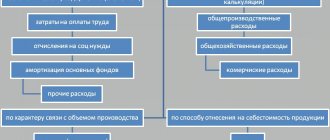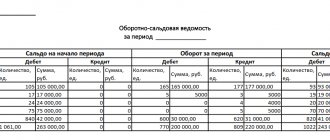Trade margin value
In order to obtain the planned profit, the seller, when selling goods, forms the cost using the amount of markup on the original cost. The resulting difference must cover all estimated costs, including the following:
- VAT and other indirect taxes;
- sales costs (third-party services, employee salaries);
- other expenses.
At the same time, the markup ensures not only the covering of expenses, but also the profit of the seller. At the same time, the value of the trade margin should not impede the further competitiveness of the product on the market in comparison with other similar items.
Account 42 in accounting
A trade margin is an added value to the purchase price of a product, used by an organization to cover the costs of selling the product, paying indirect taxes and, ultimately, making a profit.
Account 42 “Trade margin” is passive and is credited when goods are accepted for accounting in the amount of a discount (mark-up) or trade margin.
The main subaccounts 42 accounts are presented in the figure:
The purpose of analytical accounting for account 42 is to ensure separate accounting of the amounts of discounts (markups) and price differences:
- goods for retail trade;
- goods shipped.
The amount of the discount (mark-up) on the balance of unsold goods can be determined by %, based on the ratio of the amount of the discount/mark-up on the balance of goods at the beginning of the month and the turnover on KT 42 accounts without taking into account reversed amounts to the amount of goods sold and their balance at the end of the month:
Determination of trade margin
To determine the final cost of goods in wholesale and retail trade, different algorithms are used.
When selling wholesale, the trade margin is the difference between the wholesale selling price and the purchase price.
To account for retail trade, it is allowed to accept goods not only at cost, but also at final selling prices. Such actions are permissible, since sometimes it is impossible to determine the natural value of a unit of goods. An exception is a unit of large products, for example, household appliances. But when selling smaller goods (office supplies, food), detailed accounting is impossible. In retail companies, it is preferable in such cases to account for goods at selling prices.
The selling price of a product consists of the cost price and an added margin. The latter value can be established by organizations independently, with some exceptions indicated below.
It is allowed to set a markup using the Register of Retail Prices, approved by the manager. For any type of product, information is provided about the supplier, the purchase price, the amount of markup in % terms, and the final market price. Each place of subsequent sale can have its own price.
The approved register may look like this:
| Product | Provider | Cost price | Markup 1 | Retail price 1 | Markup 2 | Retail price 2 |
| Pen | LLC "Prestige" | 45.00 rub. | 30% | 58.50 rub. | 35% | 60.75 rub. |
| Pen | LLC "Titan" | RUB 54.00 | 30% | 70.20 rub. | 35% | RUB 72.90 |
| Pencil | LLC "Dream" | 25.00 rub. | 30% | RUB 32.50 | 35% | 33.75 rub. |
The markup can also be uniform for all types of goods or depend on their type. It is recommended that the chosen method of determining retail prices be fixed in the current accounting policy.
Basic postings with examples
If we consider typical transactions and account postings, we can use several options. The amount of the trade margin that has been accrued is carried out on the loan. The debit is used to write off the markup associated with the sale of goods, reducing the amount.
- Dt 41 Kt 42. This operation characterizes the fact that the accrual of the trade margin has been reflected.
- Dt 90-2 Kt 42 implies the fact of writing off the amount of the markup on product items that were sold.
- Dt 91-2 Kt 41 – the excess of the markdown amount over the markup amount was written off.
Now you should pay attention to a real practical example and consider not only the transactions, but also the amounts of transactions.
The organization Pelican LLC bought a consignment of 100 washing machines for a total amount of 1,000,000 rubles. VAT amounted to 180,000 rubles, and the size of the trade margin was 35%. Determining the value of this parameter, as well as the cost of goods for sale, the accountant made the following calculation measures:
- The trade margin is a value that can be found using the following equation: (1,000,000 – 180,000) * 35% = 287,000 rubles. for the entire consignment.
- The selling price of a batch of goods is (1,000,000 – 180,000 + 287,000) = 1,107,000 rubles.
- The retail cost of a commodity unit is 1,107,000 / 100 = 11,070 rubles.
Now you should pay attention to the underlying entries compiled for the transactions in question. It turns out that when reflecting all transactions in accounting, the accountant made the following entries:
- Dt 41 Kt 60. This posting reflects the fact that Pelican LLC received a consignment from the amount of 8,200,000 rubles.
- Dt 19 Kt 60. Here we are talking about a situation where the amount of value added tax was reflected on incoming commodity items, the amount is 180,000 rubles.
- Dt 60 Kt 51. The posting reflects the fact of transfer of funds as payment for the item.
- Dt 68 Kt 19. This indicates the fact that value added tax has been accepted for deduction.
- Dt 41 Kt 42. As part of this posting, the value of the trade margin is reflected.
These entries are directly involved in business transactions and are the most accurate for recording.
State regulation of pricing
Prices for certain products are controlled by the state. The government determines the acceptable price for certain goods that have special social significance. If a product is on the List of Price-Controlled Products, then their final cost, including markup, must be formed in accordance with current laws and regulations at the federal and local levels.
If there is a steady increase in prices for goods of social importance, the Government has the right to temporarily limit their maximum limit. But this can be done if the price increase level exceeds 30% over a 30-day period. The maximum permissible value of the cost of such goods, established by the Government, can be maintained for up to 90 days.
Socially significant goods include the following: meat, milk, sunflower oil and butter, flour, eggs, sugar, salt, bread, cereals, potatoes, some types of fruits and vegetables. In addition to food products, the list of goods for which control over selling prices can be established includes children's products, medicines, medical products, goods intended for sale in the Far North and regions equivalent to it.
If cases of overpricing are detected for goods regulated by states, the responsible persons and organizations will face fines. For management, fines of up to 50,000 rubles are provided, for legal entities - in the amount of twice the amount of revenue exceeded as a result of overstatement for the entire period of overstatement, but for a total duration of no more than a year.
Write-off of markup
If product items are no longer in circulation, measures are taken to write off the trade margin. For example, in case of sale, damage, free transfer to third parties.
If implemented
The amount is reversed in correspondence with account 90 “Sales”, subaccount “Cost of sales”. The general wiring looks like Dt 90-2 Kt 42.
What to do in case of markdown of goods
In the course of trade-related activities, some product items may lose their consumer properties, as well as their presentation. In this case, it is possible to make a decision to mark down the goods.
The amount for which this occurs is written off through the posting: Dt 41 Kt 42. If the amount of the markdown is higher than the TN indicator, the posting Dt 91-2 Kt 41 appears.
In the process of using goods for personal needs
If commodity items were used as own elements, it is necessary to write them off to account 44, as a result, the posting will take the form Dt 44 Kt 42.
Seller control scheme
- receipt of goods by quantity, acceptance of goods is noted in the invoice, certified by the signature of the materially responsible person.
- when prices change, the seller is given a register of retail prices and price tags for the goods;
- invoices are filed with the goods report and checked;
- The correctness of sales reflection is carried out by reconciling the amounts of the $Z$-report and the amount of the loaded $Z$-report into the automated system. Such an operation can be carried out automatically (a sales receipt is issued in an automated system and when the document is posted, a cash receipt is automatically printed);
- inventory is carried out.
Another advantage of keeping records using the $42$ account is tax accounting, which is carried out in purchase prices.
To switch to this system you must:
- change the accounting policy - perhaps once a year, accounting begins in the new year.
- if an enterprise operates with several stores, the accounting policy must reflect which divisions will use such a system.
Postings on account 42 - Realized trade margin
The debit of account 90 “Cost of sales” reflects the production cost of sold finished products, works, services; actual cost of goods sold (without trade margins), insurance payments in accordance with insurance contracts, for loans - written off in the order of closing debit turnover to account 79 “Financial results”. In the debit of this account, enterprises engaged in issuing and conducting lotteries on the territory of Ukraine reflect the creation (formation) of the prize fund (payment reserve) and the reserve covering the jackpot amount not secured by payment for participation in the lottery.
Administrative expenses, sales expenses and other operating expenses are not included in the production cost of finished and sold products, and therefore information on such expenses is summarized in the expense accounts of the reporting period - 92 “Administrative expenses”, 93 “Sales expenses”, 94 “ Other operating expenses."
Account 90 “Cost of sales” has the following subaccounts:
901 “Cost of finished products sold”;
902 “Cost of goods sold”;
903 “Cost of completed work and .
Subaccount 901 “Cost of sold finished products” records the production cost of sold finished products.
Subaccount 902 “Cost of goods sold” reflects the cost of goods sold, determined by Accounting Regulation (standard) 9 “Inventories”.
Subaccount 903 “Cost of sold work and services” records the cost of work and services sold during the reporting period.
In subaccount 904 “Insurance payments”, enterprises that are insurers in accordance with the Law of Ukraine “On Insurance” summarize information on insured amounts and insurance compensations under the terms of the insurance (reinsurance) agreement upon the occurrence of an insured event.
Source for Accountant.Info: Instructions on the use of the Chart of Accounts for accounting assets, capital, liabilities and business transactions of enterprises and organizations








